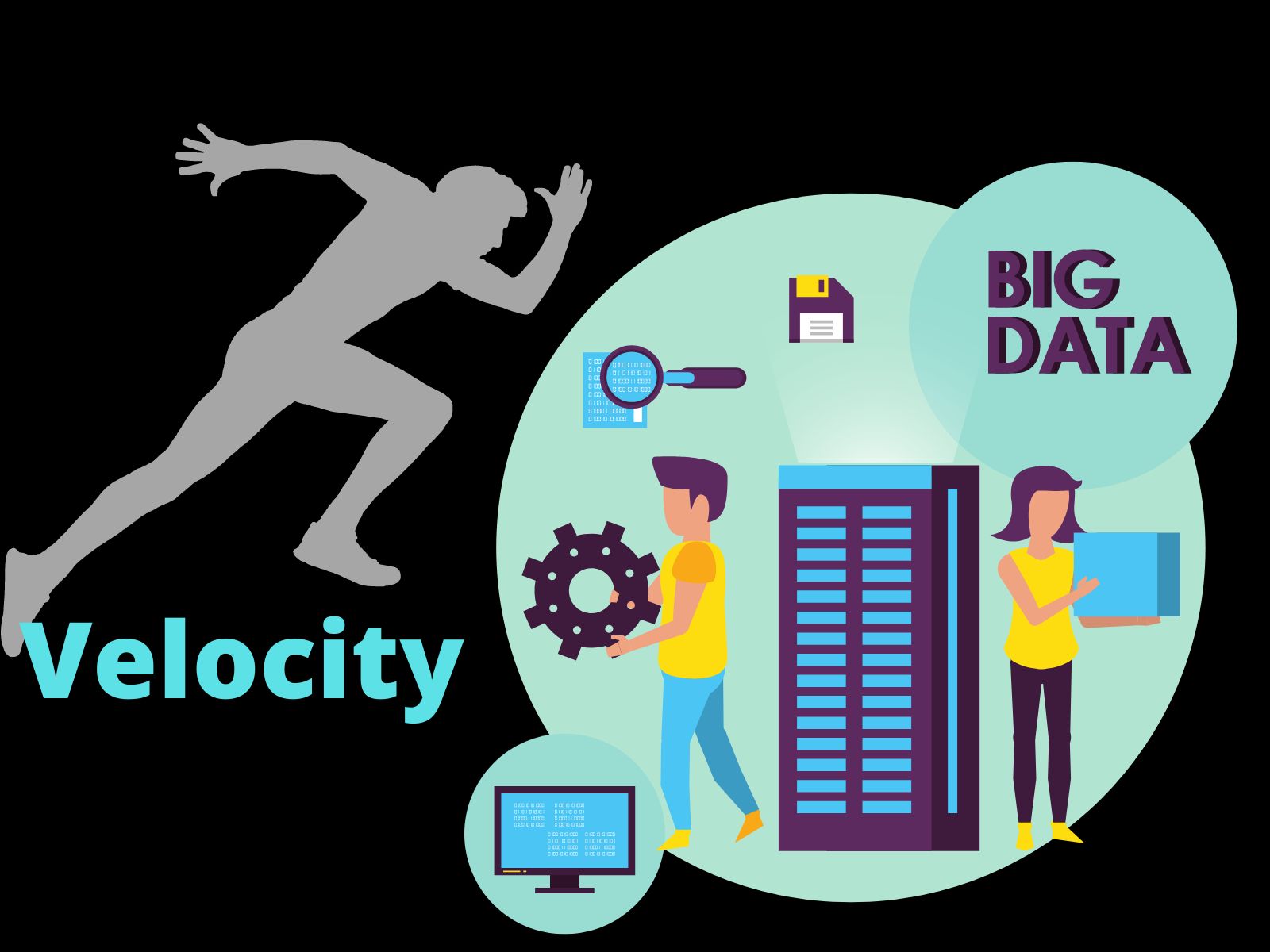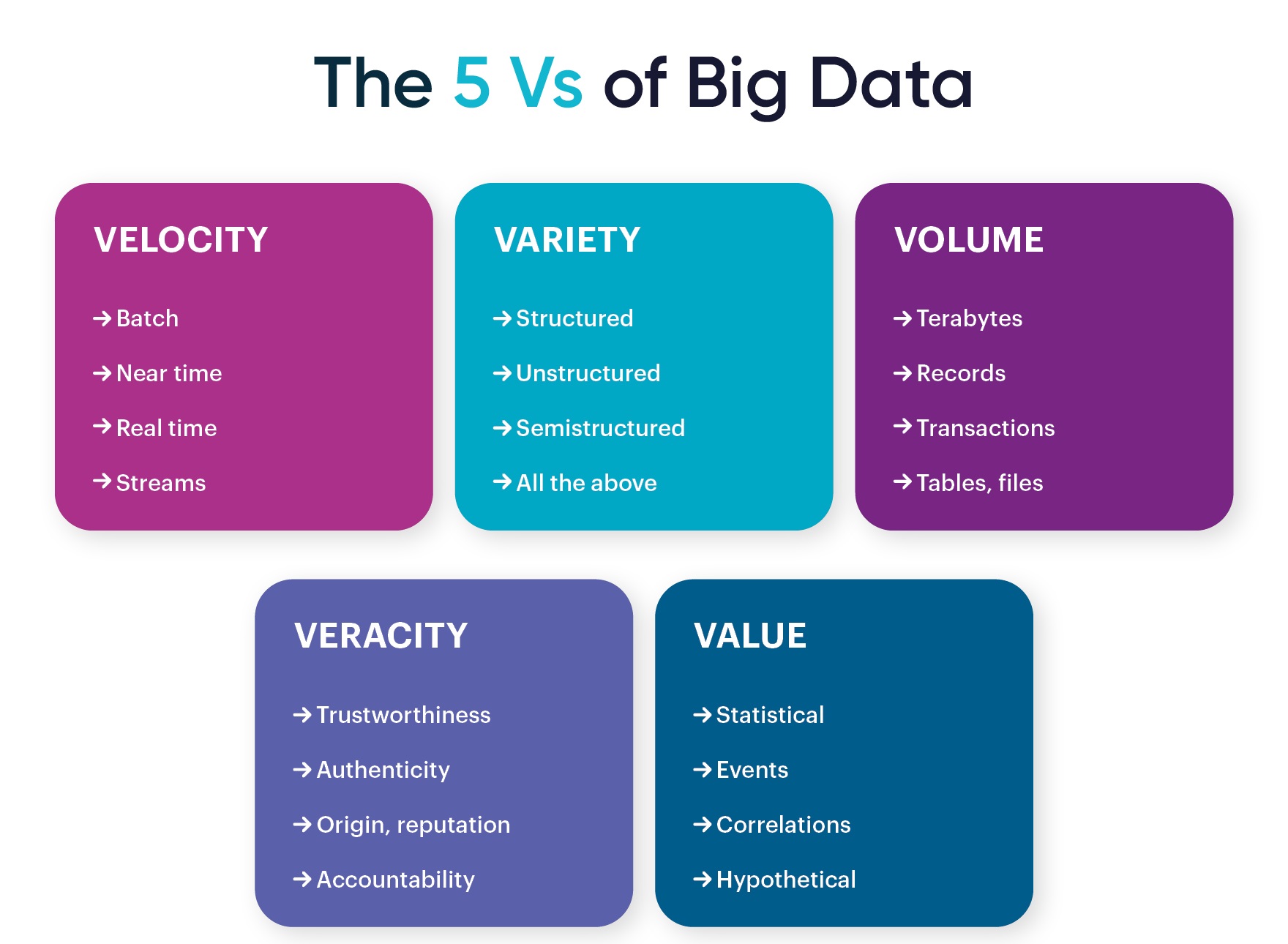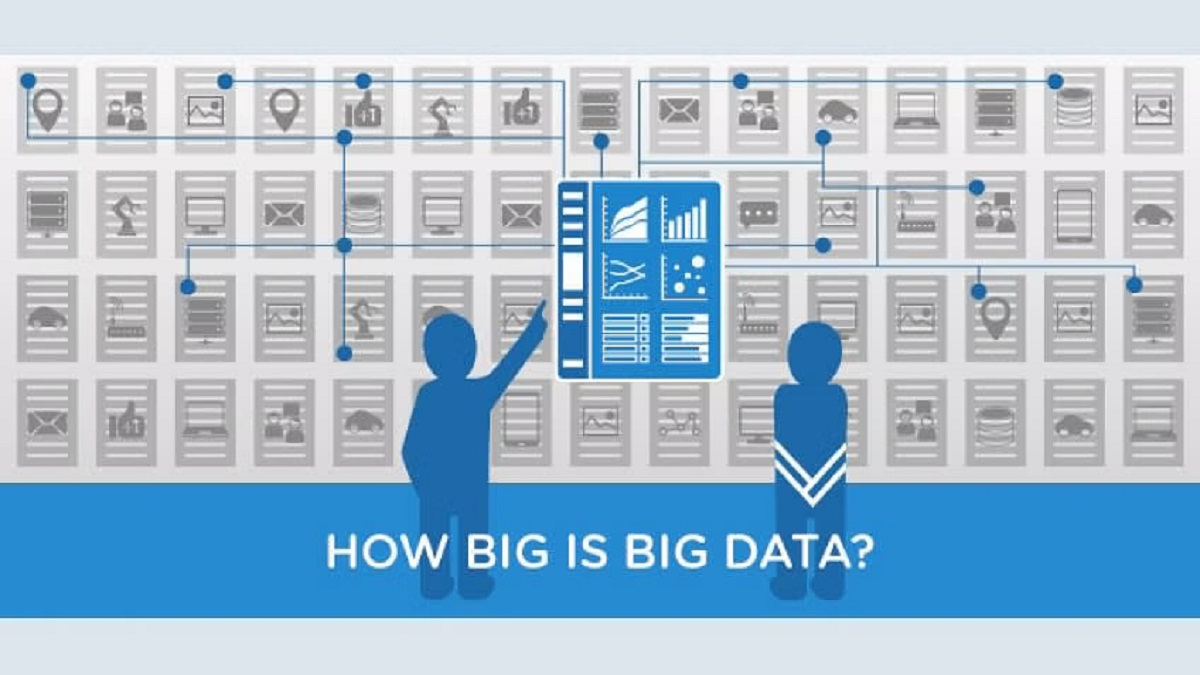Introduction
Your organization collects vast amounts of data every day – from customer profiles and purchasing behavior to website traffic and social media interactions. But how do you make sense of all this information? This is where big data comes in.
Big data refers to the large and complex volumes of data that are generated from various sources. It includes both structured data, which is organized and stored in databases, and unstructured data, which is more difficult to categorize and analyze. The ability to harness and analyze big data has become increasingly important in today’s digital age, as it provides organizations with valuable insights and actionable information.
With the advancements in technology and the proliferation of digital platforms, the amount of data being generated is growing at an exponential rate. As a result, businesses are turning to big data analytics to unlock the potential hidden within their data. By using sophisticated tools and algorithms, organizations can gain valuable insights into customer behavior, market trends, operational efficiency, and more.
However, dealing with big data is not without its challenges. The sheer volume, variety, and velocity of data make it difficult to process and analyze manually. Traditional data processing methods are often inadequate when it comes to handling big data, which is why specialized tools and techniques are required.
Big data is more than just a buzzword; it has the potential to revolutionize industries and drive business growth. Organizations that can effectively harness the power of big data gain a competitive edge over those that do not. From making smarter business decisions to improving customer satisfaction and optimizing operations, big data has a wide range of applications.
In this article, we will explore the definition of big data, its characteristics, the variety and volume of data sources, and the value and benefits it offers. We will also discuss the challenges organizations face when it comes to managing and analyzing big data. By the end, you will have a better understanding of what big data is and why it is essential in today’s data-driven world.
Definition of Big Data
The term “big data” refers to the large and complex sets of data that organizations collect from various sources, both internal and external. These data sets are characterized by their volume, velocity, variety, veracity and value, and require specialized tools and techniques to process, analyze, and interpret effectively.
Big data encompasses both structured and unstructured data. Structured data is organized and stored in a defined format such as databases, spreadsheets, or data warehouses. This type of data is relatively easy to analyze as it can be sorted, filtered, and queried using standard techniques.
Unstructured data, on the other hand, does not have a predefined format and is more challenging to analyze. It includes text documents, images, videos, social media posts, and sensor data. This data is often in large volumes and does not fit neatly into traditional databases. However, it can provide valuable insights when analyzed properly.
What sets big data apart from traditional data sets is its sheer volume. Organizations are now collecting and storing vast amounts of data, often in the terabytes or petabytes. This abundance of data provides an opportunity for organizations to uncover patterns, trends, and correlations that were previously unseen.
The velocity at which data is generated is another defining characteristic of big data. With the rise of digital platforms and connected devices, data is generated in real-time or near real-time. This fast pace of data production requires organizations to have the capability to collect, process, and analyze data quickly to derive timely insights.
The variety of data sources also contributes to the complexity of big data. Data can come from a wide range of sources, such as customer transactions, social media interactions, website logs, IoT devices, and more. Each source may have its own data format and structure, making data integration and analysis more challenging.
Veracity refers to the quality and reliability of the data. With big data, there is often a mix of accurate and inaccurate data, and it can be difficult to determine the credibility of each data point. Data cleansing and validation techniques are essential to ensure the accuracy and integrity of the data being analyzed.
Lastly, big data has inherent value for organizations. By analyzing large and diverse data sets, organizations can gain insights that support data-driven decision making. These insights can lead to improved efficiency, better customer experiences, and ultimately, increased revenue and profitability.
In summary, big data refers to the vast and complex volumes of structured and unstructured data that organizations collect from various sources. Its defining characteristics include volume, velocity, variety, veracity, and value. Understanding and effectively utilizing big data can provide organizations with a competitive advantage in today’s data-driven world.
Characteristics of Big Data
Big data is characterized by several key attributes that differentiate it from traditional data sets. These characteristics, known as the 4 Vs – volume, velocity, variety, and veracity, highlight the unique challenges and opportunities that come with managing and analyzing big data.
Volume: Perhaps the most apparent characteristic of big data is its sheer volume. Traditional data sets pale in comparison to the vast amounts of data being generated and collected today. Organizations can easily accumulate terabytes or even petabytes of data from various sources such as customer transactions, social media interactions, sensor data, and more. The large volume of data provides organizations with a wealth of information to analyze but also poses the challenge of processing and storing such massive amounts of data.
Velocity: Big data is generated at an unprecedented velocity. In today’s digital age, data is produced in real-time or near real-time. From online transactions to social media posts to sensor data, information is constantly flowing into organizations at a rapid pace. Analyzing data in motion and extracting insights from it becomes crucial to harness its value effectively. The ability to process and analyze data in real-time allows organizations to make timely decisions and take immediate actions based on the insights derived from the data.
Variety: The variety of data sources is another characteristic of big data. Data can come in various formats and structures, including structured, semi-structured, and unstructured data. Structured data refers to the organized and defined data that can be easily stored and processed using traditional databases. Semi-structured data, such as XML or JSON, contains some organizational elements but lacks a rigid structure. Unstructured data, like social media posts, emails, videos, and images, does not adhere to any predefined format. The diversity of data sources poses a challenge for organizations to integrate and analyze data from disparate sources, requiring advanced techniques to extract meaningful insights.
Veracity: Veracity refers to the reliability and credibility of data. With the abundance of data being generated, it becomes crucial to ensure the accuracy and quality of the data being collected. Big data can often contain noisy, incomplete, or ambiguous data points. It is essential for organizations to implement data validation processes and quality control measures to ensure the trustworthiness of the data used for analysis.
Organizations that embrace and understand these characteristics of big data can unlock its immense value. By effectively managing, processing, and analyzing large volumes of data, organizations can gain valuable insights, make data-driven decisions, and drive business growth.
Sources of Big Data
The sources of big data are diverse, encompassing a wide range of channels and platforms that generate vast amounts of data. These sources can be categorized into three main types: internal, external, and public sources.
Internal Sources: Internal sources of big data include the data generated within an organization’s own systems and processes. This can include transactional data from sales, customer interactions, and financial records. Additionally, data from internal systems such as CRM (customer relationship management) systems, ERP (enterprise resource planning) systems, and data warehouses contribute to the internal data sources. This data is often structured and stored in a standardized format, making it relatively easier to process and analyze.
External Sources: External sources of big data refer to data that comes from outside the organization. This can include data acquired from third-party vendors, such as market research reports, industry surveys, and demographic data. Social media platforms, online forums, and review websites are also significant sources of external data. By monitoring and analyzing this data, organizations can gain valuable insights into customer sentiment, trends, and competitive landscape. External data is often unstructured or semi-structured, requiring specialized tools and techniques to effectively extract insights.
Public Sources: Public sources of big data encompass data that is freely available to the public. This includes open government data, public records, and publicly accessible APIs (application programming interfaces) that provide access to data from various sources. Examples of public sources include weather data, census data, and financial market data. Public data sources can provide valuable contextual information for analysis or be combined with internal and external data to uncover correlations and insights.
In addition to these primary sources, organizations can also generate big data through the use of connected devices and the Internet of Things (IoT). Sensors embedded in products, machinery, or infrastructure can collect real-time data on performance, usage, and environmental conditions. This data can be utilized to optimize operations, predict maintenance needs, and improve overall efficiency.
The sources of big data are continuously expanding as technology advances, and organizations find new ways to collect and leverage data. The challenge lies in effectively integrating, storing, and analyzing these diverse data sources to extract meaningful insights that can drive decision-making and enhance business performance.
Variety of Big Data
One of the defining characteristics of big data is its variety, which refers to the diverse types and formats of data that organizations collect and analyze. Big data encompasses structured, semi-structured, and unstructured data, each requiring different approaches and tools for effective analysis.
Structured Data: Structured data is organized and stored in a predefined format. It resides in relational databases, spreadsheets, or data warehouses, making it relatively easy to process and analyze. Structured data includes transactional data, customer profiles, inventory records, and other digital data points that can be categorized and sorted systematically. Analyzing structured data often involves using SQL queries or business intelligence tools to extract insights from the structured database schema.
Semi-Structured Data: Semi-structured data does not adhere to a rigid data schema like structured data but has some organizational elements. Examples of semi-structured data include XML (eXtensible Markup Language) and JSON (JavaScript Object Notation) data. These formats provide a flexible way to store and exchange data, allowing for hierarchy and nested structures. Analyzing semi-structured data often requires applying parsing techniques and schema mapping to extract relevant information and transform it into a structured format for analysis.
Unstructured Data: Unstructured data refers to data that does not have a predefined format or organization. This includes text documents, emails, social media posts, videos, images, and sensor data. Unstructured data is generated in vast quantities and is challenging to analyze using traditional methods. However, unstructured data can provide valuable insights when processed using advanced techniques such as natural language processing (NLP), sentiment analysis, image recognition, and machine learning algorithms. Extracting meaning from unstructured data requires the ability to identify patterns, sentiment, and context within the data.
Organizations can gain significant value from analyzing all three types of data. Structured data provides insights into quantitative measures and operational efficiency, semi-structured data enables analysis of hierarchical or nested data relationships, and unstructured data offers insights into consumer sentiment, customer behavior, and emerging trends.
Moreover, the variety of big data sources extends beyond just data formats. It also includes the variety of data generated from different channels such as social media platforms, websites, mobile applications, IoT devices, and more. Each of these sources may produce a unique set of data with its own characteristics and data points. Analyzing data from these diverse sources allows organizations to gain a comprehensive understanding of their customers, markets, and operations.
The variety of big data presents both opportunities and challenges for organizations. It requires the adoption of specialized tools, technologies, and analytical approaches to effectively process, integrate, and analyze structured, semi-structured, and unstructured data. By embracing the variety of big data, organizations can unlock deeper insights and make informed decisions that drive business growth and innovation.
Volume of Big Data
One of the key characteristics of big data is its immense volume. The volume refers to the large amounts of data that organizations generate and collect from various sources on a daily basis. The proliferation of digital platforms, interconnected devices, and the advent of social media have led to an exponential growth in data production.
The volume of big data is often measured in terms of terabytes, petabytes, or even exabytes. To put this into perspective, a single terabyte is equivalent to 1,000 gigabytes, and a petabyte is a thousand times larger than a terabyte. Organizations across industries are accumulating enormous quantities of data, ranging from customer transactions and website activity logs to sensor readings and machine-generated data.
The generation of such vast amounts of data presents both challenges and opportunities for organizations. On one hand, storing, processing, and analyzing large volumes of data can be complex and resource-intensive. Traditional methods and infrastructure may not be sufficient to handle the sheer scale of data being generated. This has led to the development of technologies and frameworks for distributed storage and processing, such as Hadoop and cloud computing.
On the other hand, the volume of big data offers organizations a wealth of opportunities. By analyzing large data sets, organizations can uncover patterns, trends, and correlations that were previously unseen. This allows for data-driven decision-making, targeted marketing efforts, and improved operational efficiency.
Moreover, the volume of data enables organizations to make more accurate predictions and forecasts. With a larger sample size, statistical models can become more reliable and robust. This can help organizations minimize risks, optimize their supply chains, and identify new business opportunities.
Another aspect of dealing with the volume of big data is data storage. Traditional relational databases might not be capable of efficiently managing and storing such massive amounts of data. As a result, organizations have turned to distributed file systems and NoSQL databases that can handle the scale and velocity of big data.
Furthermore, organizations need to consider data retention and archiving strategies due to the sheer volume of data. Not all data may be relevant or useful for immediate analysis, but it could still be valuable in the future. Implementing data lifecycle management practices can help organizations prioritize and manage their data based on its value and compliance requirements.
Overall, the volume of big data presents both challenges and opportunities for organizations. To fully realize the potential of big data, organizations must invest in the appropriate infrastructure, tools, and processes to store, process, and analyze large data sets efficiently. By doing so, organizations can gain valuable insights, drive innovation, and stay competitive in today’s data-driven world.
Velocity of Big Data
The velocity of big data refers to the speed at which data is generated, collected, and processed in real-time or near real-time. With the increasing adoption of digital technologies, the velocity of data has accelerated dramatically, presenting both challenges and opportunities for organizations.
In the past, data analysis was often conducted on historical data collected over a period of time. However, with the velocity of big data, organizations now have the capability to capture and analyze data as it is being generated. This real-time data processing allows organizations to make timely and informed decisions based on up-to-date insights.
The velocity of big data is fueled by various sources, such as e-commerce transactions, social media interactions, website clicks, sensor readings, and more. These data streams are constantly flowing into organizations, requiring efficient mechanisms to capture, process, and analyze the data in real-time. This is especially critical in time-sensitive industries such as finance, healthcare, and online retail, where quick decision-making can significantly impact business outcomes.
Furthermore, the velocity of big data enables organizations to respond quickly to changing market conditions and customer needs. By analyzing real-time data, organizations can identify trends, patterns, and anomalies as they occur, allowing for agile decision-making and proactive customer engagement. For example, real-time monitoring of social media sentiment can help organizations address customer complaints or capitalize on emerging trends in a timely manner.
However, the velocity of big data also poses challenges for organizations. Traditional data processing methods may not be able to handle the high-speed, continuous influx of data. Batch processing, which operates on data collected over a specified time period, may not be sufficient for real-time analysis. This has led to the development of streaming data processing technologies, such as Apache Kafka and Apache Flink, which allow for real-time data ingestion, processing, and analysis.
Moreover, the velocity of big data requires organizations to have the infrastructure and bandwidth to handle the data flow. This includes the ability to scale storage and processing capabilities, as well as network bandwidth to handle large volumes of data being transmitted. Cloud computing and scalable data processing frameworks have emerged as solutions to address these infrastructure challenges.
In summary, the velocity of big data has transformed the way organizations collect, process, and analyze data. Real-time data processing enables organizations to make agile decisions, respond quickly to market dynamics, and provide personalized customer experiences. However, it also requires organizations to invest in appropriate technologies and infrastructure to handle the high-speed data flow effectively.
Veracity of Big Data
The veracity of big data refers to the accuracy, reliability, and credibility of the data being collected and analyzed. Unlike structured data, which conforms to a defined format, big data often contains noisy, incomplete, or ambiguous data points. This inherent challenge of data quality poses significant concerns for organizations seeking to extract meaningful insights from their data.
One of the primary issues related to veracity is data accuracy. In the era of big data, organizations collect vast amounts of data from various sources, including customer interactions, online transactions, social media posts, and sensor readings. However, not all data points are guaranteed to be accurate. This can result from human error, system glitches, or intentional data manipulation. Organizations must have measures in place to identify and rectify inaccuracies to ensure the validity of their analysis and decision-making process.
Data completeness is another factor that affects veracity. Incomplete data can lead to biased or misleading insights. For example, incomplete customer profiles may result in skewed customer segmentation or inaccurate predictions of customer behavior. Organizations need to ensure that they have mechanisms in place to collect all relevant data points to maintain data completeness and integrity.
Additionally, data ambiguity is a significant challenge when dealing with unstructured data sources such as social media posts or customer reviews. Natural language processing techniques and sentiment analysis can help organizations interpret the sentiment and meaning behind the textual data. However, inherent ambiguity in human language can make it challenging to derive accurate insights from this type of data. Organizations need to take extra caution when analyzing and interpreting unstructured data, ensuring that they have robust algorithms and validation processes in place.
Data veracity is also affected by the credibility and reliability of the data sources. With the influx of user-generated content and the spread of fake news, organizations must critically evaluate the sources of their data. Data from reputable sources, such as government agencies or trusted industry publications, can be more reliable and credible. Organizations need to establish data governance practices to assess and validate the trustworthiness of their data sources.
To address the veracity challenge in big data analysis, organizations employ various techniques and technologies. Data cleansing and validation processes are used to identify and rectify errors and inconsistencies in the data. Machine learning algorithms can be employed to detect and filter out outliers or anomalies that can negatively impact analysis results. Organizations can also implement data governance frameworks that define data quality standards, data validation protocols, and data source verification mechanisms.
Addressing the veracity challenge in big data is essential to ensure the accuracy, reliability, and credibility of insights derived from the data. By implementing robust data quality measures and validation processes, organizations can mitigate the risks associated with inaccurate or misleading data and make more informed decisions based on reliable insights.
Value of Big Data
The value of big data lies in the insights and actionable information it provides to organizations. By effectively analyzing and interpreting large volumes of data, organizations can gain a competitive advantage, drive innovation, and improve decision-making processes.
One of the primary sources of value in big data is its ability to uncover hidden patterns, correlations, and trends. By analyzing vast amounts of data from various sources and across different dimensions, organizations can identify relationships and dependencies that were previously unknown. These insights can help organizations make data-driven decisions, optimize processes, enhance customer experiences, and drive business growth.
Big data can also provide valuable insights into customer behavior and preferences. By analyzing customer interactions, website clicks, social media posts, and other sources of data, organizations can gain a deeper understanding of their customers and their needs. This enables personalized marketing efforts, targeted product development, and improved customer satisfaction and loyalty.
Moreover, big data can help organizations optimize their operations and improve efficiency. By analyzing data from supply chains, production processes, and logistical operations, organizations can identify bottlenecks, streamline workflows, and implement better resource allocation strategies. This can result in cost savings, improved productivity, and enhanced operational performance.
The value of big data extends beyond internal operations. Organizations can leverage data insights to identify market trends, predict consumer demand, and gain a competitive edge. By analyzing external data sources such as market research reports, social media sentiment, and online reviews, organizations can obtain valuable market intelligence that helps them stay ahead of the competition and seize new business opportunities.
Furthermore, big data plays a crucial role in driving innovation and fostering data-driven cultures. Data insights can spark new ideas, drive product development, and fuel continuous improvement efforts. Organizations that embrace big data and leverage it effectively are more likely to be innovative and agile in responding to market dynamics and customer needs.
From a financial perspective, the value of big data can be significant. By optimizing business operations, enhancing customer experiences, and identifying growth opportunities, organizations can achieve higher profitability and revenue growth. Data-driven decision-making can help organizations justify investments, allocate resources effectively, and reduce unnecessary costs.
Finally, big data contributes to the development of data-driven ecosystems and collaborations. Organizations can share and exchange data, creating new insights and innovative solutions through data aggregation and analysis. Collaborative efforts within industries and sectors can unlock even greater value from big data by creating data marketplaces and facilitating data-driven partnerships.
In summary, the value of big data lies in its ability to provide organizations with valuable insights, drive innovation, improve decision-making, and enhance operational efficiency. By leveraging the vast amounts of data available, organizations can optimize processes, gain a deeper understanding of customers, seize market opportunities, and achieve sustainable growth in today’s data-driven world.
Benefits of Big Data
The benefits of big data are far-reaching and have the potential to transform businesses across industries. By harnessing and analyzing large volumes of data, organizations can derive valuable insights and drive strategic initiatives. Here are some key benefits of leveraging big data:
1. Improved Decision-Making: Big data enables organizations to make more informed, data-driven decisions. By analyzing a wide range of data sources, organizations can gain deeper insights into customer behavior, market trends, and operational performance. This knowledge empowers decision-makers to make proactive and evidence-based choices, leading to better business outcomes.
2. Enhanced Customer Understanding: Big data allows organizations to gain a comprehensive understanding of their customers. By analyzing customer interactions, purchase history, and social media sentiment, organizations can identify customers’ needs, preferences, and pain points. This leads to improved customer segmentation, personalized marketing campaigns, and delivering exceptional customer experiences.
3. Operational Efficiency and Process Optimization: Big data analytics can reveal inefficiencies and bottlenecks in business processes. By analyzing data from supply chains, production lines, and logistical operations, organizations can optimize workflows, reduce costs, and improve overall operational efficiency. This can result in faster order processing, reduced waste, and improved resource allocation.
4. Predictive Analytics and Forecasting: Big data enables organizations to predict future trends and outcomes more accurately. By implementing predictive analytics models, organizations can forecast demand, identify potential risks, and make proactive decisions to stay ahead of the competition. This enables organizations to anticipate customer needs, plan inventory levels, and optimize pricing strategies.
5. Innovation and Product Development: Big data can fuel innovation and drive product development. By analyzing customer feedback, market trends, and competitor information, organizations can identify new opportunities and develop innovative products and services to meet evolving customer demands. This data-driven approach enhances market responsiveness, fosters creativity, and positions organizations as industry leaders.
6. Fraud Detection and Risk Management: Big data analytics is instrumental in detecting and preventing fraud. By monitoring transactional data, financial records, and customer behavior patterns, organizations can identify anomalies and potential fraudulent activities. This helps organizations mitigate financial risks, protect sensitive information, and ensure regulatory compliance.
7. Competitive Advantage: Extracting insights from big data provides organizations with a competitive edge in the market. By being able to analyze customer behavior, market trends, and competitor strategies, organizations can make timely adjustments to their offerings and stay ahead of the competition. The ability to leverage big data effectively differentiates organizations and creates opportunities for market leadership.
8. Real-Time Decision-Making: Big data allows organizations to make decisions in real-time or near real-time, enabling agile responses to changing market conditions. By analyzing live data streams, organizations can identify trends, detect emerging risks, and seize immediate opportunities. Real-time decision-making enhances competitiveness, customer satisfaction, and operational agility.
9. Customer Retention and Loyalty: By analyzing customer data and behavior, organizations can identify patterns that indicate customer churn. This allows organizations to proactively engage with at-risk customers, address their concerns, and offer personalized retention strategies. The insights derived from big data help organizations build long-term customer relationships, enhance loyalty, and drive repeat business.
10. Cost Reduction: Big data analytics can help organizations reduce costs in various ways. By optimizing operations, streamlining processes, and identifying cost-saving opportunities, organizations can achieve operational efficiencies and minimize waste. Big data also enables organizations to analyze and optimize resource allocation, reducing unnecessary expenses and improving overall cost-effectiveness.
In summary, big data offers numerous benefits to organizations. From improved decision-making and customer understanding to enhanced operational efficiency and competitive advantage, big data has the potential to transform businesses and drive growth in today’s data-driven world.
Challenges of Big Data
While big data offers tremendous opportunities, it also presents several challenges that organizations need to overcome in order to effectively harness its potential. Here are some key challenges associated with big data:
1. Data Management: The sheer volume of big data can pose significant challenges in terms of data storage, organization, and management. Traditional data storage systems and databases may not be sufficient to handle the vast amounts of data being generated. Organizations need to invest in scalable and distributed storage solutions, such as Hadoop or cloud-based storage, to efficiently manage and process big data.
2. Data Quality: Ensuring the quality and accuracy of big data is vital for meaningful analysis. Big data can be noisy, incomplete, and inconsistent, which can lead to biased or incorrect insights. Data cleansing and validation processes are essential to identify and rectify errors, as well as to ensure the integrity and reliability of the data being analyzed.
3. Data Integration: Big data often comes from multiple sources, such as internal systems, external vendors, and public data sets. Integrating and combining data from diverse sources can be complex, as each source may have different formats, structures, and data quality. Organizations need to establish robust data integration processes and frameworks to consolidate and harmonize the data for meaningful analysis.
4. Data Privacy and Security: Big data often contains sensitive and personally identifiable information. Organizations need to comply with data privacy regulations and ensure that appropriate security measures are in place to safeguard the data. This includes implementing data encryption, access controls, and data governance practices to protect against unauthorized access, breaches, and data leaks.
5. Scalability and Performance: Processing and analyzing big data in a timely manner can be challenging. As the volume and velocity of data increase, organizations need scalable and high-performance computing infrastructure to handle the processing demands. This may involve using distributed processing frameworks, parallel computing, or cloud-based solutions to efficiently process and analyze big data.
6. Skills and Expertise: Analyzing big data requires specialized skills and expertise. Data scientists, analysts, and engineers with expertise in data analytics, statistics, programming, and machine learning are highly sought after. However, there is a shortage of professionals with these skills, making it a challenge for organizations to build and maintain a skilled data analytics team.
7. Ethical Considerations: Big data raises ethical concerns surrounding data privacy, bias, and transparency. Organizations must ensure that data analysis and decision-making processes are fair and unbiased. Transparent policies for data collection, consent, and use are critical to maintain public trust in the organization’s handling of big data.
8. Cost Considerations: Implementing big data analytics infrastructure, tools, and processes can be costly. Organizations need to invest in hardware, software, training, and data management solutions. Additionally, the cost of storing and processing large volumes of data can quickly escalate. It is essential for organizations to carefully plan and budget for their big data initiatives.
9. Cultural Adoption: The adoption of big data analytics requires a cultural shift within organizations. It involves a change in mindset, from relying on intuition and experience to data-driven decision-making. Organizations must promote a culture that embraces data analysis, encourages experimentation, and rewards innovation to fully leverage the potential of big data.
In summary, while big data offers numerous opportunities, organizations must address challenges related to data management, data quality, integration, privacy, scalability, skills, ethics, cost, and cultural adoption. By overcoming these challenges, organizations can effectively harness the power of big data and unlock its potential to drive innovation, improve decision-making, and gain a competitive advantage.
Conclusion
Big data has emerged as a powerful force in today’s data-driven world. It encompasses large volumes of structured and unstructured data from diverse sources, offering organizations valuable insights and opportunities for growth and innovation. The characteristics of big data – volume, velocity, variety, veracity, and value – pose both challenges and benefits for organizations.
By effectively harnessing the power of big data, organizations can gain a competitive advantage, make data-driven decisions, optimize operations, understand their customers better, and drive business growth. However, organizations must also address challenges related to data management, quality, integration, privacy, scalability, skills, ethics, cost, and cultural adoption in order to fully realize the potential of big data.
To leverage big data, organizations need to invest in scalable infrastructure, adopt advanced analytics tools, and acquire the necessary skills and expertise. Implementing effective data governance practices, ensuring data quality, and complying with privacy regulations are crucial in managing big data responsibly. Moreover, fostering a data-driven culture and promoting collaboration and innovation are vital for maximizing the value of big data.
As technology advances and the amount of data continues to grow, big data will remain a critical factor in shaping the success of organizations across industries. Organizations that embrace big data and harness its power effectively will be well-positioned to thrive in today’s fast-paced and competitive business landscape.
In summary, big data provides organizations with unprecedented opportunities to gain insights, drive innovation, and make informed decisions. By overcoming the challenges associated with big data and embracing its value, organizations can unlock its full potential for sustained growth and success.

























